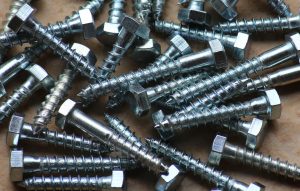
A screw is a self-drilling fastener that’s characterized by a threaded exterior. When driven into a surface, the screw’s threaded exterior digs and removes material, allowing for easy insertion into the respective object. For woodworking applications, though, certain types of screws perform better than others. One of the most popular types of screws used to join multiple wood objects together, for example is a lag screw. So, what is a lag screw exactly?
What Is a Lag Screw?
Also known as a coach screw in the United Kingdom, a lag screw is a large metal screw — typically featuring a hexagonal head — that’s designed for high-stress applications. While they are available in different sizes, most measure about 1 to 3 inches long and at least 0.25 inches thick. Of course, other screws have significantly smaller. With their longer and thicker design, lag screws are exceptionally strong and durable, making them ideal for woodworking applications in which multiple heavy objects are joined together.
They are called “lag screws” because they were originally used to secure wooden lags.
Benefits of Lag Screws
Lag screws can withstand significant stress without breaking or otherwise succumbing to damage. As a result, many manufacturing companies — as well as many construction companies — use lag screws to join heavy objects. Because they are longer and thicker than other screws, lag screws offer a higher level of performance. Their strong and durable properties keep them in place, even under the pressure of heavy objects.
In addition to their exceptional strength and durability, lag screws are long-lasting. A typical lag screw features a high-carbon steel core with a galvanized zinc exterior. The presence of the galvanized zinc protects the law screw’s underlying steel core for rust and corrosion. Moisture and oxygen can’t easily penetrate galvanized zinc, so lag screws generally don’t rust or corrode. They can last for decades, all while offering a high level of stability to security to the objects on which they are used.
Furthermore, the American Society of Mechanical Engineers (ASME) also has standards for lag screws, such as the B18.2.1 For these reasons and others, lag screws are a popular fastener used in many woodworking applications.
In Conclusion
A lag screw is essentially a large, heavy-duty screw used in woodworking applications. They typically feature a hexagonal head with a protective galvanized coating. The exterior coating protects the law screw from rust and corrosion, while the hexagonal head allows for easy insertion and removal using common tools and tool bits.
